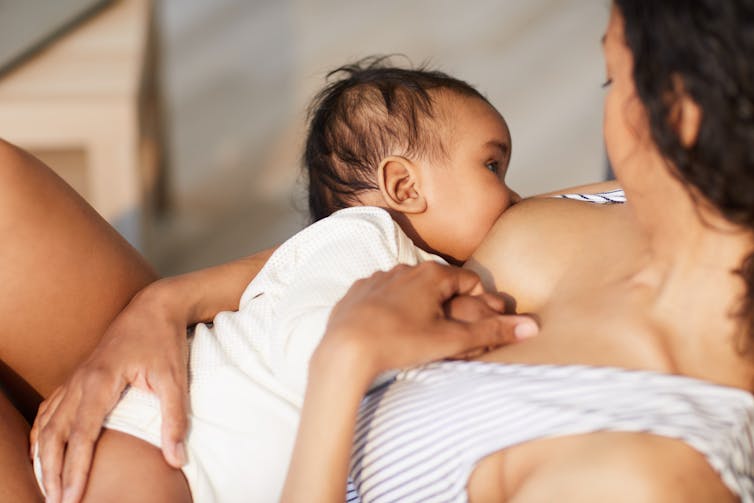Any new infectious disease poses unique challenges to people who are pregnant during an outbreak. The effects of Sars, Zika and influenza in pregnancy highlight the potential immediate and longer term detrimental health outcomes a virus can have for both mother and baby. These risks include premature delivery of the baby with Sars, birth defects with Zika and greater risk of severe influenza.
Should we be as worried about pregnancy and COVID-19? There are a number of things we need to think about. These fall into two broad areas related to the effects on the foetus and the effects on the pregnant person themselves.
In both cases we need to think about the immediate effects during the pregnancy as well as the longer term health effects for both parent and child. The early evidence we have shows that changes to the immune system during pregnancy could be somewhat protective against the disease.
The parent
Early data from pregnant women with COVID-19 indicates that the disease is linked to premature birth and changes to the placenta that might reflect altered blood flow. This suggests that virus-associated disruptions do occur between parent and foetus.
However, these studies were of women with severe cases of the disease. We know very little about the effect of mild disease or asymptomatic infection in pregnancy. Understanding this is critical, as studies have highlighted that asymptomatic and mildly infected pregnant women far outnumber those requiring hospitalisation for COVID-19.
This indicates that pregnant people are not more susceptible to severe COVID-19, which was one of the greatest concerns at the beginning of the pandemic and led to them being categorised as vulnerable.
The apparent protective effect of pregnancy against severe disease might simply reflect the different immune responses to severe COVID-19 seen in men and women, and the fact that more men than women die from the disease in general. However, we do not see the same response in pregnancy with other viruses, such as influenza, suggesting something else is at play with SARS-CoV-2.
The foetus
So far, it seems that the foetus is very well protected from the passage of SARS-CoV-2 from mother to child (known as vertical transmission) and such passage, while possible, seems to be uncommon. This might be down to the natural features of the placenta, which produces molecules that stop the virus binding to placental cells. It could also be that the placental membranes limit infection by the virus.
Of course, it is very difficult to study the placenta prior to birth. Alternative measures, such as analysing cellular debris released from the placenta (known as extracellular vesicles) which can be found in a sample of the mother’s blood, are really needed to find out what features of the placenta might protect the foetus from infection and what effects the virus has on the placenta.
Any antibodies that a mother infected with SARS-CoV-2 makes will pass to the foetus across the placenta (known as passive immunity). This provides short-term protection from many infectious agents for the last months of pregnancy and for some months after the baby is born. These antibodies will also continue to be provided in breast milk if the baby is breast fed.

SeventyFour/Shutterstock
Early studies from China have shown that antibodies that protect against COVID-19 are present in newborns of women who had such antibodies. This confirms that passive immunity, where a baby essentially inherits antibodies from a parent, occurs with SARS-CoV-2. We now need some larger studies to investigate whether anti-SARS-CoV-2 antibodies are present in human milk to better understand the role of these antibodies in neutralising the virus and protecting the baby.
Molecules other than antibodies can also pass from parent to foetus. Pregnant women with severe COVID-19 have many of the hallmarks of an inflammatory response that we see in other people with similar symptoms. This includes elevated levels of molecules such as interleukin-6 (IL-6), which indicates that the immune response has been activated.
There are a number of studies showing that maternal immune activation can have detrimental effects on the developing foetus. Such activation is associated with increased risk of respiratory, cardiovascular, neurodevelopmental and other disorders in the offspring. Whether SARS-CoV-2 will have such long-term effects on the health of these children remains to be seen.
The role of the immune system
In a previous article, we discussed how the immune system changes during pregnancy, and it might be that unique features of this and other dynamic adaptations that occur with pregnancy provide protection from severe COVID-19.
Other examples of possible protective mechanisms include differences in the receptor molecules used by SARS-CoV-2 to invade human cells. Angiotensin-converting enzyme 2 (ACE2) is the best known of these viral entry receptors but CD147, CD26 and others also have this role.
All of these receptors undergo changes during pregnancy, which might contribute to resilience. These receptors also occur as soluble forms that can be measured in blood and breast milk and might act as decoy receptors, stopping the virus from binding to cells.
What next?
Elaborating on why both the pregnant person and their child seem to be relatively resilient to severe forms of COVID-19 might help us understand other disease processes and identify ways to combat the disease.
Work from the UK Obstetric Surveillance System has shown that, as with the wider population, Asian and Black pregnant women are more likely to be admitted to hospital with SARS-CoV-2 infection. Therefore, we really need to consider the effects of ethnicity and other risk factors in our studies of COVID-19 in pregnancy.
This is especially important as these studies will support efforts towards the use of any vaccine in pregnancy.
![]()
Catherine Thornton receives funding from Ser Cymru 2, Welsh Government.
April Rees does not work for, consult, own shares in or receive funding from any company or organisation that would benefit from this article, and has disclosed no relevant affiliations beyond their academic appointment.











